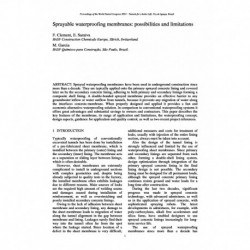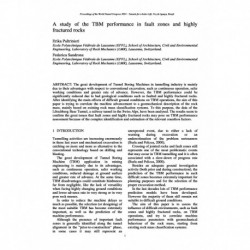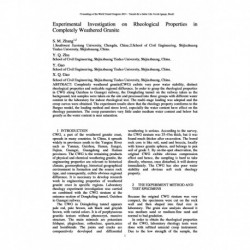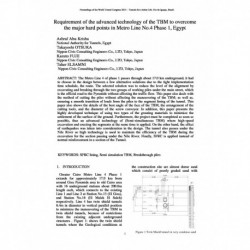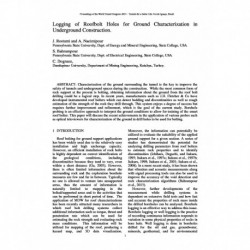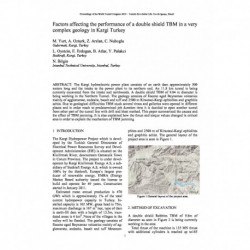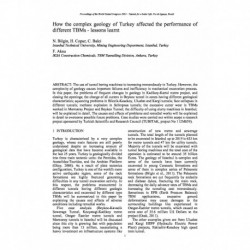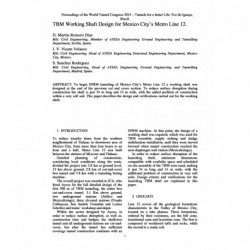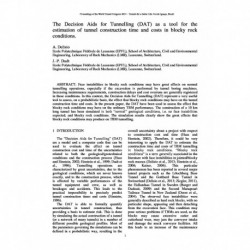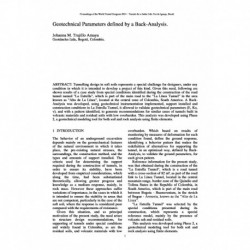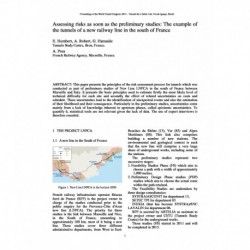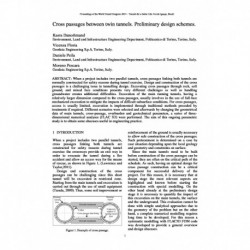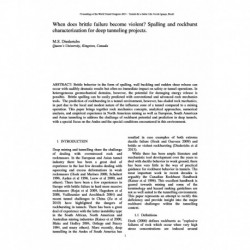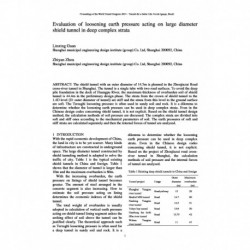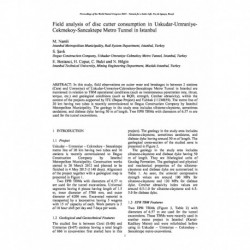No document
Search & filter
Search for a publication
Search & filter
World Tunnelling Congress
WTCThere are 1984 documents.
-
Sprayable waterproofing membranes: possibilities and limitations
Abstract: Sprayed waterproofing membranes have been used in underground construction sincemore than a decade. They are typically applied onto the primary sprayed concrete lining and covered later on by the secondary concrete lining, adhering to both primary and secondary linings forming a composite shell lining. A double-bonded sprayed membrane provides an effective barrier to any groundwater inflow or...
0,00 € -
A study of the TBM performance in fault zones and highly fractured rocks
Abstract: The great development of Tunnel Boring Machines in tunnelling industry is mainly due to their advantages with respect to conventional excavation, such as continuous operation, safer working conditions and greater rate of advance. However, the TBM performance could be significantly reduced due to bad geological conditions such as faulted and highly fractured rocks. After identifying the...
0,00 € -
Experimental Investigation on Rheological Properties in Completely Weathered Granite
Abstract: Completely weathered granite(CWG) exibits very poor water stability, distinct rheological properties and noticable regional difference. In order to grasp the rheological properties in CWG along Guizhou to Guangxi railway, the Dongkeling tunnel on the railway taken as the background, test samples were taken on the site and processed into three groups with different water...
0,00 € -
Requirement of the advanced technology of the TBM to overcome the major hard points in Metro Line No.4 Phase 1, Egypt
Abstract: The Metro Line 4 of phase 1 passes through about 17.0 km underground, it had to choose in the design between a few alternative solutions due to the tight implementation time schedule, the route. The selected solution was to reduce the level of the alignment by excavating and breaking through the two groups of working piles under the main street, which is the...
0,00 € -
Logging of Roofbolt Holes for Ground Characterization in Underground Construction
Abstract: Characterization of the ground surrounding the tunnel is the key to improve the safety of tunnels and underground spaces during the construction. While the most common form of rock support at the present is bolting, obtaining information about the ground from the roof bolt drilling could be a logical step. In recent years, manufacturers such as J.H. Fletcher & Co have developed instrumented...
0,00 € -
Factors affecting the performance of a double shield TBM in a very complex geology in Kargi Turkey
Abstract: The Kargi hydroelectric power plant consists of an earth dam approximately 500 meters long and the intake to the power plant in its northern end. An 11.8 km tunnel is being currently excavated from the intake and northwards. A double shield TBM of 9.84 m diameter is being working in the Northern Tunnel. The geology consists of Eocene aged...
0,00 € -
How the complex geology of Turkey affected the performance of different TBMs - lessons learnt
Abstract: The use of tunnel boring machines is increasing tremendously in Turkey. However, the complexity of geology causes important failures and inefficiency in mechanical excavation process. In this paper, the problems of frequent changes in geology in Kadikoy-Kartal metro project, and closing the openings; the change of all cutters in Beykoz tunnel in zones having different geological...
0,00 € -
TBM Working Shaft Design for Mexico City’s Metro Line 12
Abstract: To begin EPBM tunneling of Mexico City’s Metro Line 12 a working shaft was designed at the end of the previous cut and cover section. To reduce surface disruption duringconstruction the shaft is just 34 m long and 14 m wide, with the added problem of construction within a very soft soil. This paper describes the design and verifications carried out for the workingshaft.
0,00 € -
The Decision Aids for Tunnelling (DAT) as a tool for the estimation of tunnel construction time and costs in blocky...
Abstract: Face instabilities in blocky rock conditions may have great effects on normal tunnelling operations, especially if the excavation is performed by tunnel boring machines. Increasing maintenance requirements, construction delays and cost overruns are generally registered in these conditions. In this context, the Decision Aids for Tunnelling (DAT) represent a very useful tool to assess, on a...
0,00 € -
Geotechnical Parameters defined by a Back-Analysis
Abstract: Tunnelling design in soft soils represents a special challenge for designers, under any condition in which it is intended to develop a project of this kind. Given this need, following are shown results of a case study from special conditions identified during the construction of the road tunnel named "La Estrella", which is part of the main road to the “La Línea Tunnel” in the area known as...
0,00 € -
Assessing risks as soon as the preliminary studies: The example of the tunnels of a new railway line in the south of...
Abstract: This paper presents the principles of the risk assessment process for tunnels which was conducted as part of preliminary studies of New Line LNPCA in the south of France between Marseille and Italy. It presents the basic principles used to estimate firstly the most likely level of technical difficulty for each site and secondly the effect of related...
0,00 € -
Cross passages between twin tunnels. Preliminary design schemes
Abstract: When a project includes two parallel tunnels, cross passages linking both tunnels are normally constructed for safety reasons during tunnel exercise. Design and construction of the cross passages is a challenging issue in tunnelling design. Excavating cross passages through rock, soft ground, and mixed face conditions presents very different challenges as well as handling groundwater creates...
0,00 € -
When does brittle failure become violent? Spalling and rockburst characterization for deep tunneling projects
Abstract: Brittle behavior in the form of spalling, wall buckling and sudden shear release can occur with audibly dramatic results but often no immediate impact on safety or tunnel operations. In heterogeneous geomechanical domains, however, the potential for damaging energy release is possible. Brittle spalling can be easily predicted with conventional and advanced rock mechanics tools. The prediction...
0,00 € -
Large Caverns for Metro Stations in Buenos Aires
Abstract: Buenos Aires Metro Line H, in Argentina runs N-S, at the west side of the city's downtown area. An extension of the line started in 2011. A TBM tunnel and one cut&cover station will be built southbound in estuary soft holocene soils; CTM (conventional tunneling method) tunnel and three cavern stations are being built northbound in stiff cemented silts and clays. The...
0,00 € -
Evaluation of loosening earth pressure acting on large diameter shield tunnel in deep complex strata
Abstract: The shield tunnel with an outer diameter of 14.5m is planned in the Zhoujiazui Road cross-river tunnel in Shanghai. The tunnel is a single tube with two road surfaces. To avoid the deep pile foundation in the dock of Huangpu River, the maximum thickness of overburden soil of shield tunnel is 44.4m in the preliminary design phase. The strata from the crown of shield tunnel to the 1.4D level (D:...
0,00 € -
Cekmekoy-Sancaktepe Metro Tunnel in Istanbul
Abstract: In this study, field observations on cutter wear and breakages in between 2 stations (Carsi and Umraniye) of Uskudar-Umraniye-Cekmekoy-Sancaktepe Metro Tunnel in Istanbul are mentioned in relation to TBM operational conditions (such as instantaneous penetration rate, thrust, torque, etc.) and geological conditions (such as RQD, strength, Cerchar abrasivity), within the context of the projects...
0,00 €

